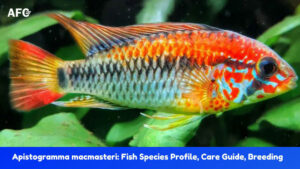Freshwater Angelfish are a beautiful species of fish, and they’re extremely popular among fish hobbyists. They are fun to watch, add a lot of charm to an aquarium, and typically keep to themselves. When it comes to add angelfish to your tank, there are many questions that come up such as “are angelfish aggressive?”
In this article we’ll explore what angelfish aggression really looks like and why is my male angelfish attacking the female as well as what is the best thing you could do if your angelfish fighting each other. So keep reading to find out everything you need to know!
Are Freshwater Angelfish Aggressive?
Generally, angelfish have a reputation for being a great tank mate and peaceful community fish in a community aquarium. They are known to get along swimmingly with other tropical species and plenty of other fish.
Angelfish belongs to the Cichlid family, they are typically most aggressive during their breeding times for a variety of reasons. Female angelfish can also be aggressive in response to protecting their eggs from tank mates, and male angelfish can become aggressive over choosing mates when other males are also looking to choose tank a mate.
Why is My Angelfish so Aggressive?
Angelfish want to be the dominant fish in your tank. They communicate through chemicals that are released into the water through their excrements, which establishes their status within the tank.
If you’re changing the tank’s water too frequently, you may be forcing them to reestablish their status, causing fights among other fish.
If your angelfish feels crowded, doesn’t have a place to hide, or is stressed, they may be acting aggressively in response. Angelfish are naturally peaceful yet feisty, so you want to ensure you’re doing everything you can to provide them with their ideal environment.
Are Angelfish Aggressive with Each Other?
Cichlids are known for being on the aggressive side, with the angelfish being one of the more tame species. There are several reasons why angelfish tend to become aggressive with other angelfish.
If their environment is not ideal, it can cause stress and aggression. Angelfish need plenty of space, hiding places, and low current in the tank. Being territorial leads to them developing the pecking order and determining the dominant fish.
If you have two male angelfish in your aquarium, they’re more likely to become a lot more aggressive with each other.
Are Male or Female Angelfish More Aggressive?
Both male and female angelfish will be aggressive for different reasons, but typically males are the more common aggressor. Most of the time, angelfish become aggressive over territory in the community tank.
If two or more males are kept together without providing them with enough space, it can get ugly.
Females can become aggressive after spawning, as they want to protect their eggs.
Why is My Male Angelfish Attacking the Female?
Male angelfish will attack female angelfish over territory, but more likely, it’s usually right before spawning. Pair of angelfish will posture or twitch and attack each other before spawning. If they continue to be aggressive with each other after spawning, the male may have eaten the eggs.
When the male and female angelfish pairs are breeding, it can also appear aggressive, so keep that in mind.
Are Angelfish Aggressive Towards Other Fish in Community Tank?
Angelfish can definitely become aggressive with other types of fish, especially ones that are equally as territorial as they are. It can cause severe stress for them.
Angelfish can also prey to larger omnivores who are also territorial and aggressive fish, like Betta fish.
It’s recommended that you pair angelfish with other Cichlids, Oscars, or other large species that aren’t known for aggression.
You should avoid take mates that have the tendency to nip, like Serpae Tetras. Since angelfish have long and delicate fins, they can sustain significant damage when other fish chase and nip at them.
Do angelfish eat other fish? Be careful when adding small fish to an angelfish tank as they will eat any fish that fits. They are omnivores, and any fish that fits in their mouth will likely get eaten, labelling them as a predator.
How To Stop Angelfish From Being Aggressive
As a tank owner, you can do everything right and still have angelfish that’s being aggressive occasionally, but you can minimize the conditions for aggression to occur.
Add Hiding Places
Since they are territorial, you likely won’t avoid any aggression that comes along with that, but you can do your best to provide plenty of space, a variety of hiding spots, and setting them up in their ideal environment, which can help prevent boredom-related illnesses like fin rot or ich.
Plants are a great choice for hiding places, especially ones with large leaves like anubias. Driftwood and ornaments also make good homes in tanks.
Have More Females Than Males
If you want to have a peaceful angelfish tank, one of the best things you can do is make sure that there are more females than males.
When there are more males than females, we’ve noticed that they become much more aggressive towards other males when competing for a female. In the meantime, the males are going to be constantly harassing the females, which will cause females more stress.
In general, you should have 3 female angelfish to every male angelfish. You can always have more females than males in your tank if possible.
Introduce New Fish Properly
When you’re adding new fish to your established tank, especially other angelfish, you will want to introduce them properly. It’s recommended to have them meet as soon as possible to establish their dominance immediately. Many hobbyists opt to get two or more angelfish at once to get the introductions over with.
Suppose you have a dominant angelfish already when introducing a newcomer. In that case, you may want to consider taking the dominant one out of the tank for a few days, keeping it in a separate tank.
Doing this allows the newcomer to get comfortable with the tank, find hiding spots they like, and meet their tank mates. You can rearrange any decor and then put the original fish back in to avoid fighting.
Make Sure The Tank Isn’t Crowded Or Too Small
If you’re seeing the aggression becoming a little too frequent, you may want to invest in a larger tank if you feel that’s a contributing factor. Since they’re territorial, not having adequate space can cause stress and aggression. You will also want to keep the current to a minimum as angelfish aren’t overly agile, and it can cause stress.
Make Sure They’re Getting Enough Food
You also need to make sure you’re feeding your angelfish enough. If they don’t get fed enough, then obviously it’s going to start fighting for food!
Feed your angelfish for two minutes at a time. You should be giving as much food as they can eat the whole time, and don’t feed them more than you know they can take of in one sitting (generally about 1 to 2 teaspoons).
Don't Change Water too Frequently
One of the most important ways to avoid aggression is to not change the water too often. Angelfish establish their dominance through the water, their urine, and excrements. If you’re changing the water too often, it can lead to angelfish having to reestablish dominance each time.
Overview
Angelfish(Pterophyllum scalare) are relatively easy to care for, and while they can become aggressive, there’s typically a reason for why they do so. As long as you ensure you’re not cleaning their water too often, you’ve given them ample space and hiding spots, have a low current, and pair them with fish they get along with, you should have no problem with your beautiful new aquarium addition.





